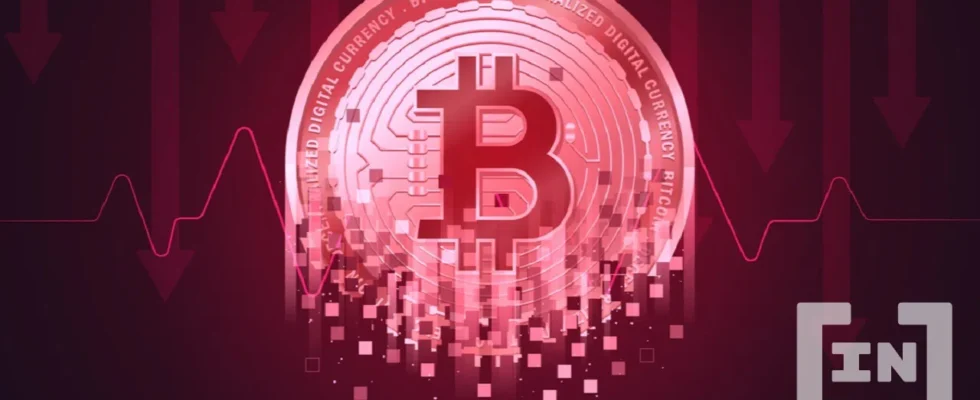Bitcoin market sentiment is starting to darken. The Federal Reserve (FED) announced on December 15 that the measures introduced as part of the economic recovery program will be lifted.
Could this announcement increase the risks of another collapse in crypto assets, including Bitcoin, and lead to a larger correction in the cryptocurrency market?
Bitcoin Market Goes Into “Extreme Scare”
Shortly before the Federal Reserve’s monetary policy meeting, the cryptocurrency market and Bitcoin in particular, continued to trend lower.
When the Federal Reserve announced its Wednesday meeting on quantitative easing policies and interest rates, the Bitcoin market was plunged into “extreme fear”.
Bitcoin is trading at $48,000, which is significantly lower (30% lower) than its all-time high of $69,000 achieved in November.
The Fear and Greed Index (Fear and Greed) within the overall market attitude ranges from zero to one hundred. Market sentiment is fearful when the index approaches its lower bound. The reverse is true for greed, i.e. when people start buying assets due to FOMO (Fear Of Missing Out). Currently, the fear and greed index is at 16, which indicates a level of “extreme fear”.
After the Federal Reserve meeting, the US central bank could try to limit inflation by raising interest rates, according to several major media.
Financial markets should therefore be prepared to change their investment patterns. Nevertheless, the FED reacted quickly to prevent consumer prices from exceeding the 2% mark. That said, this decision should not take effect until next year.
At present, the market’s expectation of a possible rapid collapse in asset purchases is not hypothetical.
Late last month, Fed Chairman Jerome Powell indicated that the central bank’s bond-buying initiative could end earlier than expected due to rising inflation rates and strengthening of the American economy.
The US central bank will reduce its bond purchases
Last Wednesday, Bitcoin rebounded to $49,000 as the Federal Reserve announced its intention to accelerate the process of withdrawing stimulus.
According to some analysts, the Federal Reserve’s decision had already influenced the price, which means that some traders had already abandoned long positions, which led to attractive price levels for short-term buyers.
Indeed, the Federal Reserve plans to reduce its bond purchases by $30 billion each month. That’s twice as fast as the current withdrawal rate of $15 billion each month.
According to CoinDesk’s Brad Keoun, some bitcoin traders believe the move will make the cryptocurrency more attractive, making it a hedge against inflation.
Currently, digital asset prices are stabilizing after the massive sell-off that took place earlier this month.
In the space of 24 hours, the price of Bitcoin gained around 3%, compared to an increase of 14% for Solana’s SOL token and 4% for Ethereum.
According to Delphi Digital, a crypto research firm, quoted in a note published on Wednesday, the price action will be more sideways/choppy towards the end of the year.
Even so, any major volatility spike or riskless event that penalizes risky assets would likely weigh on Bitcoin and the broader crypto market.
Bitcoin Losses Could Grow
During Bitcoin’s latest correction, its holders experienced an acceleration in recorded losses (costs falling below their starting price). Negative returns can prompt selling in many cases, as traders are usually scared of further market declines.
Glassnode, a crypto data firm, pointed out in a blog post that it is currently noticing an acceleration in losses among BTC holders. Twice during this correction, losses reached more than $1 billion in one day.
Bitcoin’s price decline from its all-time high of around $69,000 has made market investors more cautious. According to Glassnode, the volume of losses raised fears of another selloff.
Nevertheless, despite these high losses, blockchain data indicates that a few investors are hanging on to their BTCs.
For example, the BTC balance on exchanges declined in 2021, which could mean investors are keeping Bitcoin in their wallets rather than making it available for sale through exchanges.
An increasingly close relationship between crypto and traditional assets
Bitcoin’s weekend selloff and subsequent rebound show the volatility of the crypto market and its increasingly close relationship with traditional asset classes.
Some investors said some of the latest selloffs were the result of liquidations on alternative exchanges.
They were also triggered by concerns over Federal Reserve policy, market risk and interest rates, which rocked stocks and markets for several days.
According to Nicholas Cawley, analyst at DailyFX, there is a connection between high-risk and more active stock indices, such as the crypto market and the Nasdaq. This correlation was not as strong a few years ago.
Over the past couple of years Bitcoin has grown in popularity and a lot of investors have added it to their portfolios.
A survey by Grayscale Investments revealed that around 26% of investors in the United States own crypto assets.
The same study was done two years ago, and rather than focusing on the number of Bitcoin holders, it focused on the number of people who buy into the idea of investing in the asset.
Investors have allocated $9 billion to crypto funds this year. Additionally, assets under management for crypto funds have grown from $18.8 billion in 2020 to $73 billion currently.
Market sentiment: What does Bitcoin hold for us?
Even after the Fed meeting, crypto investors should not give up too soon. Bitcoin still has a future ahead of it and things could turn out for the better.
Of course, there are many challenges at the moment, but it is possible that things will improve over time.
How do you feel about bitcoin? Feel free to discuss this and many other topics in our group on Telegram.
Disclaimer
All information on our website is published in good faith and for general information purposes only. Any action taken by the reader based on information found on our website is entirely at their own risk.
